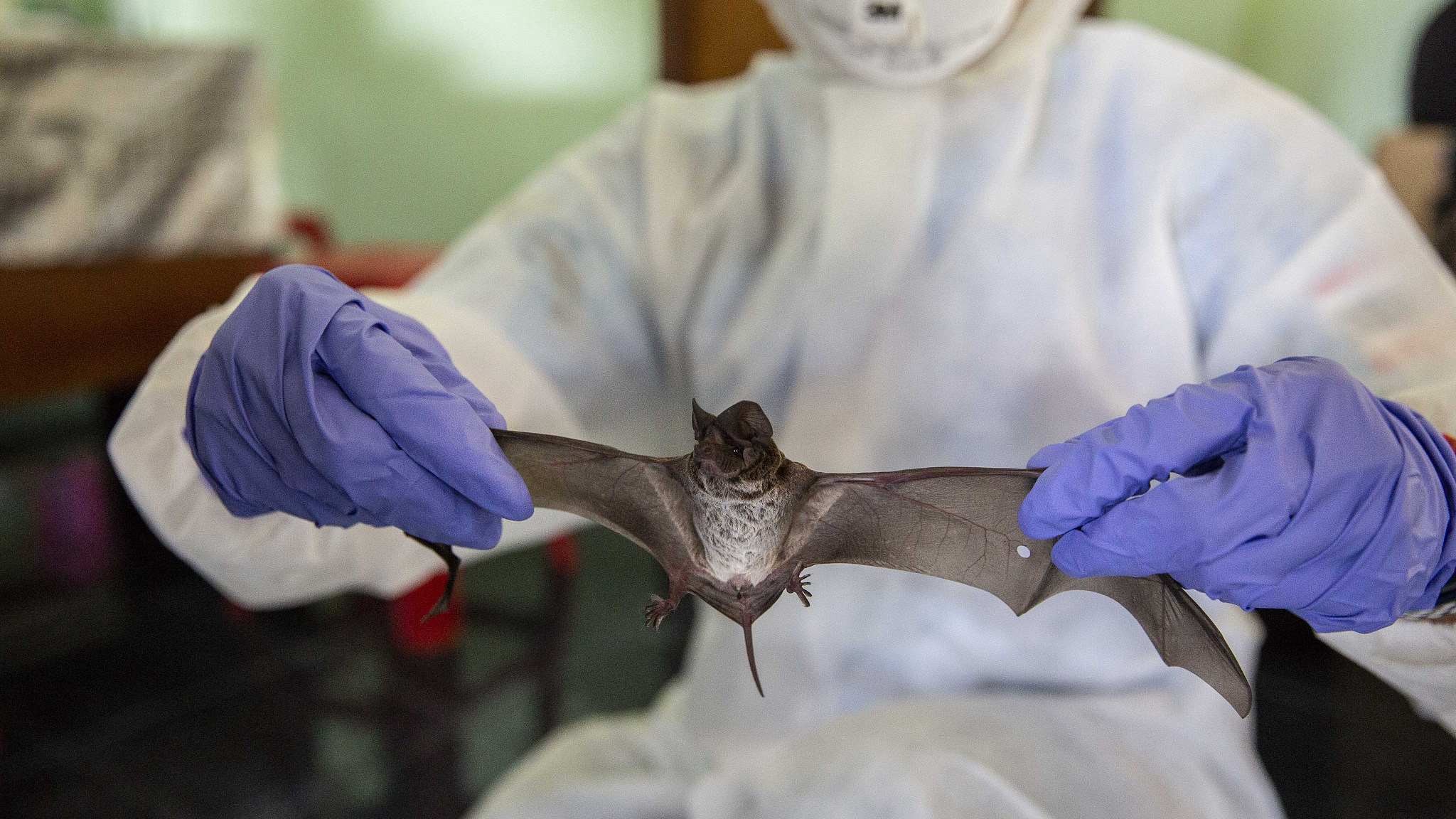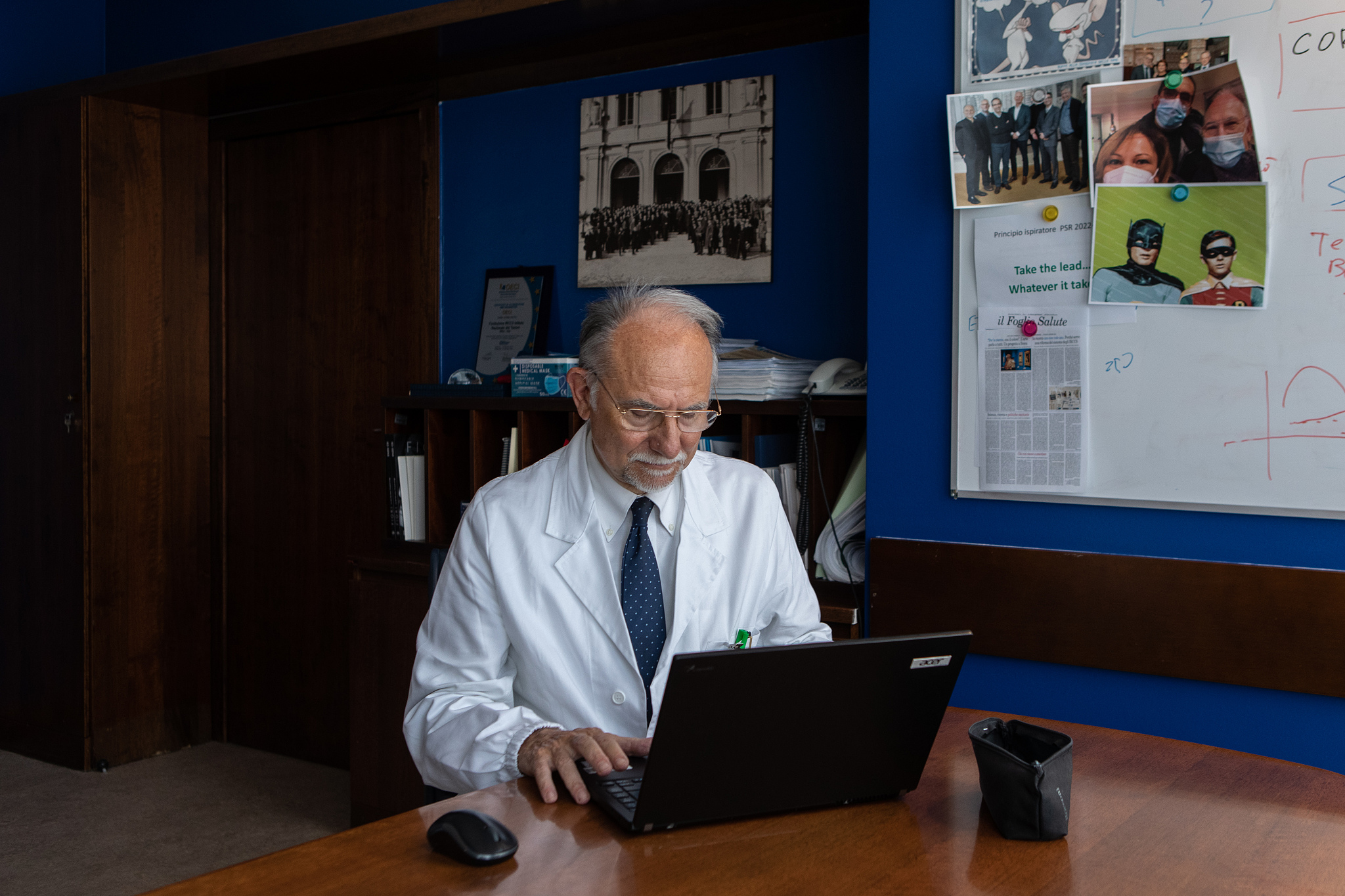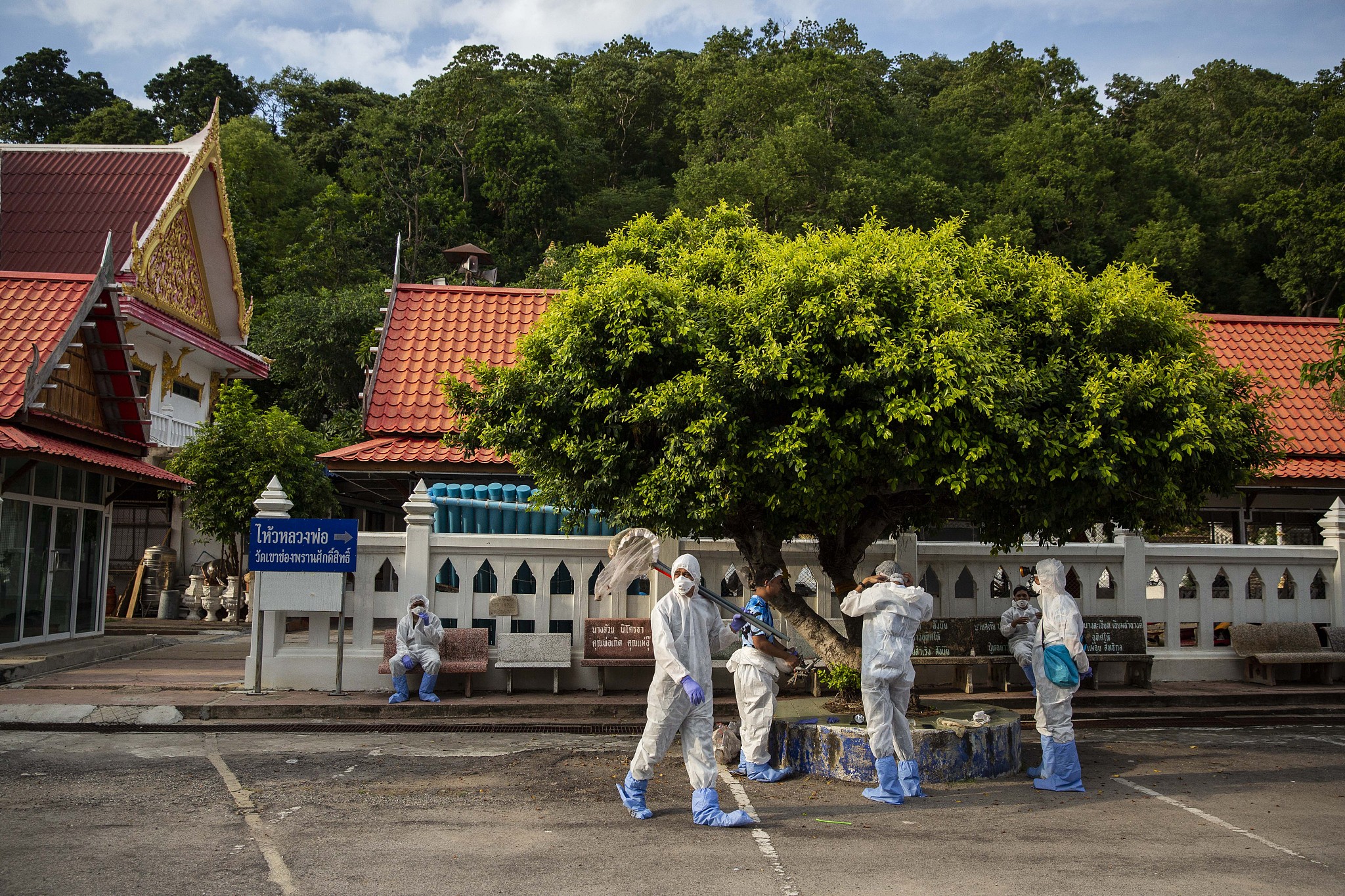25:43

As the global death toll from COVID-19 surpasses 4.6 million, the most polarizing question and central mystery remain: where did the novel coronavirus come from? Earlier this year, after a 4-week probe in Wuhan, a WHO-China joint team said the virus most likely jumped from nature to humans via an intermediate animal, and that any kind of laboratory incident is extremely unlikely. How did the team make their assessment? How did the experts from China and abroad work together?
Liu Xin had an exclusive interview with the co-lead of the animals and environment group of the WHO-China joint team, Prof. Tong Yigang. He's from the College of Life Science and Technology at Beijing University of Chemical Technology.
The interview was originally conducted in Chinese. Below is a translation of the interview.
Liu Xin: Professor Tong, you were the co-leader of the joint WHO-China team's animals and environment group. Now the joint report of the joint mission was released in March 2021, says the introduction of the virus through an intermediate host is considered a likely to very likely pathway. What is the basis of this estimate? Which animals are such potential hosts?
Tong Yigang: Nice to see you. Thank you for this question. On this issue, we have had repeated discussions with WHO experts, and done some comparisons of different scenarios. One of the most likely routes of transmission that we got is probably through intermediate hosts. This is a result that we came up with after comparing the positive evidence with the negative evidence.

Bat sampling in a laboratory in Ratchaburi Province, Thailand, September 12, 2020. /CFP
Bat sampling in a laboratory in Ratchaburi Province, Thailand, September 12, 2020. /CFP
According to the results of the current study, bats are the most likely natural host, because we have found many bats - not only in China or in Southeast Asia, but in many countries carrying similar viruses. The viruses with the highest homology to SARS-CoV-2 are also found in bats. So bats are the most likely natural host. The bat does not have much direct contact with humans, so the possibility of it directly transmitting the virus to humans is relatively small. We think it is more likely to be transmitted through an intermediate host, and so far, we have not found many possible intermediate hosts.
So far, we have found a few animals that are more likely to transmit the novel coronavirus. One is the pangolin which carries a virus close to SARS-CoV-2, but the difference between the virus found in the pangolin and SARS-CoV-2 is still very large. And, up to now, there is no evidence to prove that SARS-CoV-2 originated from pangolins. Other animals, including cats and dogs, have been shown to be infectious.
It was recently discovered that the white-tailed deer in the United States appear to be infected with the novel coronavirus in large numbers. Antibodies to the virus were found in some samples of the species in 2019, which indicates that it is possible that the novel coronavirus was already present in white-tailed deer in 2019. This is also of value to our research on tracing the origins of the virus. We feel it necessary to further understand the genome sequence of the virus carried by the white-tailed deer. Through the comparison of the genome sequences, we can see whether the virus carried by the white-tailed deer is at an early or late stage of mutation, and what kind of relationship it has with the origins of SARS-CoV-2. This is very helpful for our future research on COVID-19 origins-tracing.
I would also like to talk about another recent development. In Italy, a patient with skin disease was found to carry the novel coronavirus. Some of these early samples were collected in August and September 2019, three months before the first confirmed case in Wuhan. This evidence is also more conclusive, because the virus was not only found in the patient's blood, but also in the urine. Besides, antibodies were detected in the patient's serum, which meant that both its nucleic acid sequence and antibodies were found, so this finding is relatively more credible.

National Cancer Institute of Milan suggested in June 9, 2021, that the coronavirus might have been circulating in Italy since September 2019. National Cancer Institute of Milan, Milan, Italy, June 17, 2021. /CFP
National Cancer Institute of Milan suggested in June 9, 2021, that the coronavirus might have been circulating in Italy since September 2019. National Cancer Institute of Milan, Milan, Italy, June 17, 2021. /CFP
Liu Xin: So do you believe, given the kind of research and finding discovered in Europe, for instance, about earlier possible existence of virus as early as last summer, even last Autumn. Do you think the intermediate host hypothesis is still very likely?
Tong Yigang: It's not contradictory. The latest evidence from Italy and Europe only proves that these people were infected at an early stage, so the patients themselves cannot determine the source of infection. It is almost impossible to determine that. But this incident drops us a hint: maybe through the study of these patients, we can figure out the occupational characteristics or history of exposure of some early infected people. On top of the evidence, we may come across, we can look for a possible animal source. The virus is definitely of animal origin, and we have to study further as to what kind of animal it is, whether it's passed to humans through an intermediate host or directly from a natural host.
Liu Xin: In March 2020, you together with 28 other scientists published an article in Nature, titled Identifying SARS-CoV-2-related coronaviruses in Malayan pangolin. The article said you identified SARS-CoV-2-related viruses in pangolins smuggled into southern China from southeastern Asia. So how did that research in your eyes help us understand where the virus could potential come from?
Tong Yigang: That incident actually happened very early. It was back in late 2017 and early 2018 when we received some samples of pangolins that were sick and dead for unknown reasons, and these samples were obtained from an animal rescue center. The purpose of such rescue centers was to raise, and rescue protected animals intercepted from smugglers. But during the rescue process, the animals became sick and died for unknown reasons. So, they sent us samples for analysis. In the process of analysis, we found that there was a coronavirus in these animals that were local to Southeast Asia, because the pangolin population in China is very small, and the pangolins sent to us were Malayan pangolins, not a native Chinese species.
We didn't pay particular attention to the virus after we analyzed it, thinking that it was just a new coronavirus. So, we didn't know how significant it was. In fact, we didn't confirm that this coronavirus was the cause of the pangolin's death because at that time, not only was the coronavirus found in these samples, but also some other viruses, like the canine parvovirus.
Then after the COVID-19 outbreak, the sequence of SARS-CoV-2 was released. We found through comparison that the original coronavirus found in the pangolins was very homologous to SARS-CoV-2. It was more homologous to SARS-CoV-2 than some other viruses, but it was not as homologous as the virus carried by bats.
But from another point of view, we can assume that the coronavirus in pangolins may have common ancestors with SARS-CoV-2 in the evolutionary process, and there are some evolutionary interactions between them. For example, there may be recombination of parts of their genomes. This was a relatively important finding at that time because there were no other coronaviruses that were close to SARS-CoV-2. So, pangolins are actually one of the early species, other than bats, we found to carry a kind of coronavirus very close to SARS-CoV-2.
Its significance is that it may help us understand the origins of the novel coronavirus. However, it cannot prove that SARS-CoV-2 originated from pangolins, because it is still very different from the coronavirus in pangolins.

Tong Yigang at a press conference in Beijing, China, March 31, 2021. /CFP
Tong Yigang at a press conference in Beijing, China, March 31, 2021. /CFP
Liu Xin: In March, you said in a press briefing that more than 38,000 samples of livestock and poultry, and more than 41,000 samples of wild animals from around China collected between 2018 to 2020 have been tested for SARS-CoV-2. And none of the samples tested positive. What does that tell you? Will future studies focus on more species or include more species that could be susceptible to SARS-CoV-2?
Tong Yigang: Thank you for the question. After the outbreak of COVID-19, the Chinese government and scientists in China paid a lot of attention to the source of the novel coronavirus. Since the pandemic first broke out in China, we were highly suspicious at first that the virus could come from some place or animal in China. So not only did scientists do a lot of research on their own initiative, anyone who had the resources and ability was doing research in this area. The Chinese government also attaches great importance to this area of work and has been encouraging scientists and government departments to reach out for samples and carry out research in this area.
So, after the outbreak, we collected tens of thousands of samples from poultry and wild animals, but unfortunately, we did not find any trace of SARS-CoV-2 in these wild and domestic animals. We did not even find any virus that was 70 or 80 percent homologous to SARS-CoV-2, so we doubted our initial idea that the virus originated from China. Although we can't rule out that possibility because we haven't tested all animals in China so far, we increasingly feel that the source of the virus is not likely to be inside China after so much effort. As more evidence emerges, we feel that the virus could come from foreign countries, because the virus with the highest homology to SARS-CoV-2 is found in bats. Similar virus is found in large numbers in bats in Yunnan Province which lies in southern China and borders several countries. It is possible that this virus comes from some of Chinas neighboring countries. Other recent studies have also shown that many of Chinas neighboring countries do have viruses that are homologous to SARS-CoV-2. In those countries, even some samples from 10 years ago had SARS-CoV-2 homologs. The recent sample from the Italian patient also shows it is likely that the early infected people are not from Wuhan, or from China.
Liu Xin: So, you just said that it is unlikely that the original virus was not from China. But on the other hand, at this moment, we know that coronavirus that is very close to the SARS-CoV-2, which is called RaTG13, is found in bats in southern China. Do the two findings contradict each other?
Tong Yigang: Instead of contradicting each other, I think they can corroborate each other. Why do I say so? As we have just said, we have done a lot of work, and we have not found any virus in any animal in China that is anywhere close to SARS-CoV-2, let alone being the same.
There are several countries in Southeast Asia that have found viruses that are close to SARS-CoV-2 and have a high homology to SARS-CoV-2, which means that they are related.
Bats are often found in Yunnan Province which borders Southeast Asian countries, and bats can fly. Sometimes, they can fly long distances. Through migration, it would allow the virus to exist and spread over a wide area.
Then outside of Yunnan, there may be some viruses carried by bats in Chinas neighboring countries that may be the real source of SARS-CoV-2. Of course, we still need scientific evidence. That is just an assumption, and it also requires more research. We hope that scientists from countries around the world can cooperate more under the coordination of the WHO or other organizations to study the origins of the virus and to do some research in more regions and on more animals.

A group of researchers completed the task of capturing bats at Khao Chong Pran cave in Ratchaburi province, Thailand, September 12, 2020. /CFP
A group of researchers completed the task of capturing bats at Khao Chong Pran cave in Ratchaburi province, Thailand, September 12, 2020. /CFP
Liu Xin: What is the latest work on the search for potential hosts by Chinese researchers in China if any? And what specifically are they doing?
Tong Yigang: Of course, this work is not over yet, because the source of the novel coronavirus has not been found. We keep an ongoing interest in this issue, and it is an important one, because it may serve as lesson in case of the emergence of another pandemic in the future. So, we still need to figure out the origins of the virus.
We're continuing to trace the origins of the virus. We're trying to obtain more samples of domesticated and wild animals, and searching for other wild species, including highly suspicious species of bats, and then running tests on them. There's actually data that flows out constantly. There may also be more scientific literature that will be reported in the near future.
Liu Xin: The Joint China-WHO report states that SARS-CoV-2 leaks through a laboratory incident were considered to be an extremely unlikely pathway. How did the experts come to that consensus? What does "extremely unlikely" mean?
Tong Yigang: I think there are probably three reasons why the virus is highly unlikely to be leaked from a lab. In fact, those reasons were fully discussed with the WHO experts at that time, which led to the conclusion you see in the report.
Historically, there have been many outbreaks caused by leaks of pathogens, but the problem here is that all of those leaks happened because someone was cultivating them and studying them. They were something that existed in the lab and were known to people, so those leaks were accidents caused by improper handling or mismanagement.
But when the pandemic struck Wuhan, there was no lab in Wuhan that knew about such a virus, and there was no lab working on such a virus. So, this was a scenario completely different from any lab leak in history. Therefore, it's completely unfounded to infer that SARS-CoV-2 came from a lab leak based on the fact that there were lab leaks in history.
The second reason is that the Wuhan Institute of Virology is an institute built according to international standards. It is one of the best-equipped and most advanced institutes in China. Its level of management is also very high, and it is managed in accordance with international standards. In terms of the level of safety management, it is impossible for it to have a leak. Not only does it have good management, but it also offers training to people from other countries. I know some of their training programs. So, I think it is impossible for such a strictly managed lab specializing in biosafety research to have such a leak.
The third reason is based on the evidence we have. After the outbreak, the local government, and the Wuhan Institute of Virology itself tested the sera of all staff members and also carefully investigated the health condition of all their staff members. It was found that at the time of the outbreak in Wuhan, not a single person at the Wuhan Institute of Virology was infected with COVID-19, despite the relatively high case load in the city. This is an objective fact, and it is well documented. So, some people say someone at the Wuhan Institute of Virology was infected. It is just a made-up story. There is no evidence to prove it.
Why do so many people keep talking about lab leaks? In fact, I think the problem is that many people prefer to hear conspiracy theories because they sound more exciting. But if you want to prove the origins of the virus, you need scientific evidence. In the absence of scientific evidence, people tend to tell stories. At the same time, many like to hear them. Consequently, they are widely circulated. In my opinion, scientists should stick to facts and find evidence to prove a certain theory.
The conclusion after the lab investigation in Wuhan was that a lab leak was highly unlikely. There's also a sentence added after that saying in the absence of new evidence to prove a link to a lab, the WHO would no longer carry out investigations in this area.

World Health Organization (R) and Chinese experts shake hands after a press conference in Wuhan, China, February 9, 2021. /Getty Images
World Health Organization (R) and Chinese experts shake hands after a press conference in Wuhan, China, February 9, 2021. /Getty Images
Liu Xin: How did you and your foreign counterparts work in Wuhan in January and February this year? Did you, for instance, sometimes would have differences or debates? If so, what would be the major ones, and how did you reach the final agreement that is reflected in the final report?
Tong Yigang: In the course of our joint investigation with the foreign experts, we were both very positive and friendly, and both sides cooperated very well. In most cases, we were in agreement because we were both judging on the basis of scientific facts. We would analyze each possibility of virus transmission and cite evidence from the positive and negative side to discuss the possibility.
So, we got similar or identical conclusions in many cases, but there were times when there was some disagreement in terms of wording and both parties would present their views about the wording, but this did not affect our overall conclusions.
In this process, there may be some differences. For example, there may be some minor differences on the issue of cold chain transportation, but in the end there's a consensus that the possibility of the virus being introduced into Wuhan through the cold chain exists and is possible.
Liu Xin: So finally, how do you look at the fact that the U.S. intelligence community was tasked with coming up a report on the origins of COVID-19. And what kind of impact will such practice have on the international scientific research on the origins of COVID-19?
Tong Yigang: I don't think it's appropriate for me to answer this question. I think as scientists, we talk in the language of science, and we look at things from a scientific point of view. As we are discussing these issues, it inevitably involves the exchanges that we had with WHO experts in the phase-one investigation. I am making some explanations based on my experience, but some topics are too political, and I don't think I am good at commenting on that.

